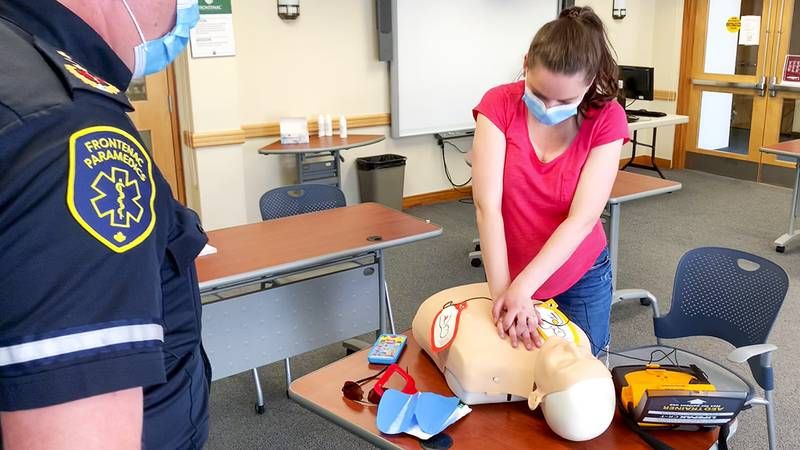Kelli McRobert | Jul 26, 2023
(Reporter Kelli McRobert has gone through the process of becoming a Community Responder with the “Neighbours Saving Neighbours pilot program, and she has prepared a primer for he benefit of readers who are interested in joining the program)
The Zoom session was over.
Eager participants had completed the initial meeting to find out more about a program that is being launched within the Frontenacs. Each candidate had taken the first step in preparing themselves to become ‘Community Responders’ for their local area. Next, they needed to complete a Police Check for Vulnerable Sector (CVS) and submit basic information about themselves. Those interested must have met some general requirements, including being over 21, having a smartphone and a vehicle, being in reasonably good health, and available for training.
Those that continued, would need to complete Safety Training and Awareness online, and then submit their marks back to the lead trainer Jason of the Frontenac Paramedics.
From there, you would attend, in person, their centre on John Counter Boulevard and get FIT tested for proper Personal Protective Equipment (PPE), that would be used if you were to attend a call. Supported by the Frontenac Paramedics, this program is being led by Queen’s University and Dr. Brooks (Cardiac Specialist) to demonstrate a need for shorter arrival times by responders with life saving equipment. The framework itself based on a program from Aberdeen, Scotland, where they have had success with reducing patient wait times during a cardiac event, and thus helping to improve survival rates.
Candidates now get their photos taken, and then schedule a time to attend in-person training for CPR and GoodSAM software that is used on your personal cell phones. I was fortunate enough to get in quickly and last week completed the training with 5 other fellow responders. Our class consisted mainly of retired police, fire, nurses, dispatchers, and civic minded residents wanting to help when needed. We shared a few stories of why we were there and then launched right into physiology and CPR itself.
It was nice to see that the practical side has changed considerably from what we were taught years ago. I used to have nightmares about how many times to count, compress, breathe, measure, repeat … it was a lot to take in if you did not use it often. It is now super simplified with the 30-compression count, 2 breaths, that I felt comfortable I could administer it without over thinking! The new machines are also much improved as not only do they walk/talk you through each stage, but they also have great visual cues, colors, and sounds, to help guide you each step. It is fool proof insofar as you cannot shock someone unless the machine detects a need.
For the next few hours, we practiced, repeated, modified slightly for children and infants, and then ran through it one more time to get a good feel and get comfortable with the various machine models, sounds, bells, and whistles. We also got acquainted with our first responder kits that were provided to us with basic tools & PPE. It was a bit exciting to don and doff our gloves, glasses, masks, and robes, and yet, one must hope we will never have to use them?
Final exam done, and we then worked through the GoodSAM APP on our phones to better understand how we would be notified of a call if we were in the area. Up to 3 volunteers could be dispatched to support the first responders. We do have the option to decline the call if unavailable or upon arrival we feel the location or situation is unsafe to enter. Upon completion of the all-day training, we signed any remaining paperwork, were given our AEDs (Automated External Defibrillator), our kits, supplemental PPE, and ID tags.
Currently, there are 50 trained ‘Frontenac Paramedic Community Responders’ and the hope is to increase that number before the upcoming launch of the program. If you are looking for something a bit different, and a way to support your community, this may be an opportunity for you to explore. Just think, if each smaller community has a responder, the web of increased support will continue to grow, and who knows, the life you save, may be a friend, a relative, or a neighbour.
I know Godfrey now has a responder, and I will continue to share this with my friends to expand the NsN reach northbound, one defib at a time.
Please consider joining the group or sharing it with someone you think would be keen. Let’s show that South, Central, and North Frontenac have a strong, compassionate community, that will lead by example. Let’s work together to save lives and support the Queen’s Research Department so that the program can continue to receive the necessary funding.
For those interested in the program and NsN volunteer application form you can find it https://engagefrontenac.ca/neighbours-saving-neighbours
More Stories
- Latest CUPW Job Action Stops Postal Delivery Of The Frontenac News Forcing Alternate Plans
- Opponents of Barbers Lake Gravel Pit Pack Ag Hall in McDonalds Corners
- Bobsleigh Olympian Jay Dearborn At Mikes Pizza In Sydenham
- The Loins Club Of and O'Lakes Roar
- North Frontenac Back Roads Studio Tour - September 27 and 28
- Sunday Market Vendors Give Back
- George Street Work As Town Hall Renovation Nears Completion
- One Way Street Plan Hits A Dead End - Central Frontenac Council, September 9
- Global Gardening
- No Winner Yet in Catch The Ace But Fundraising Target Met

